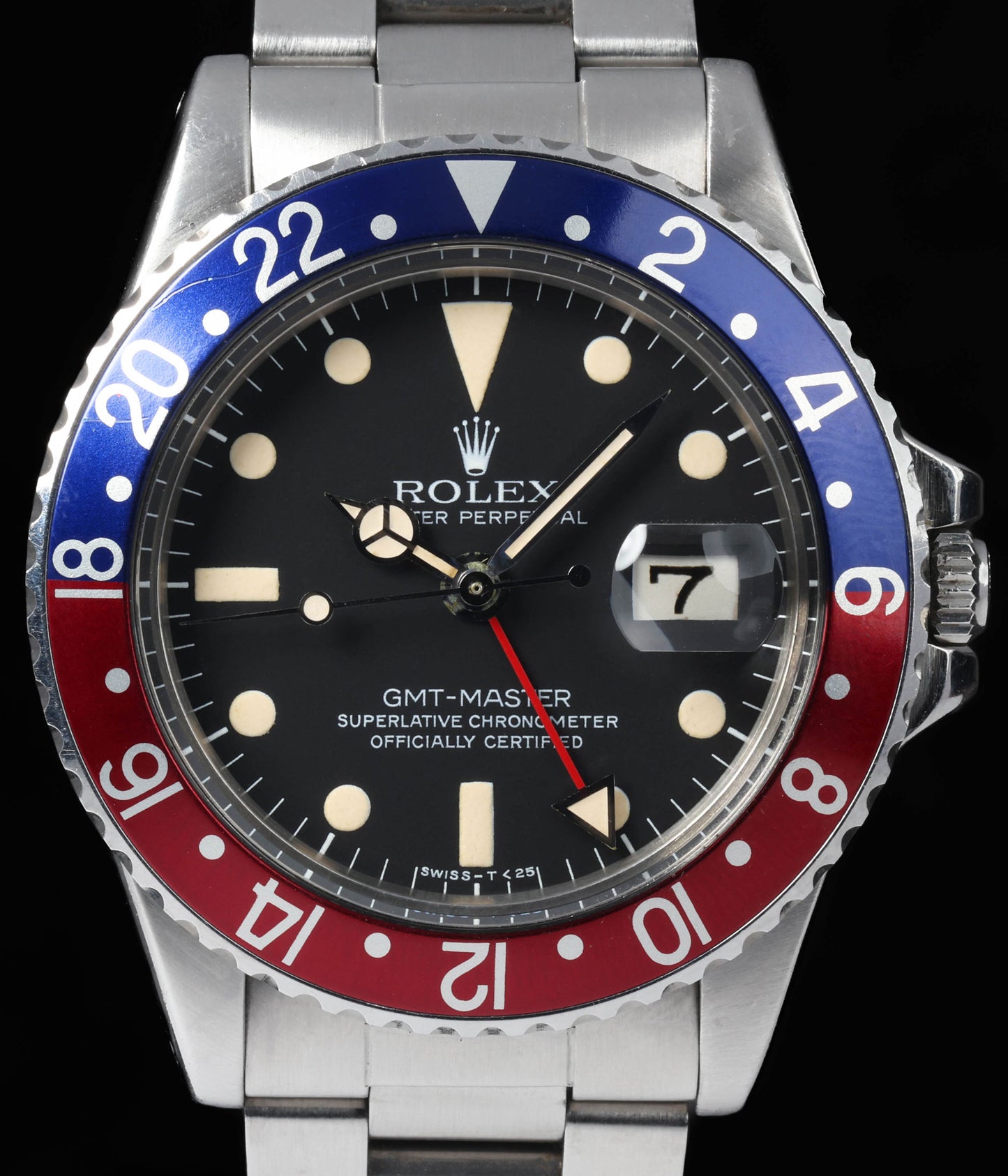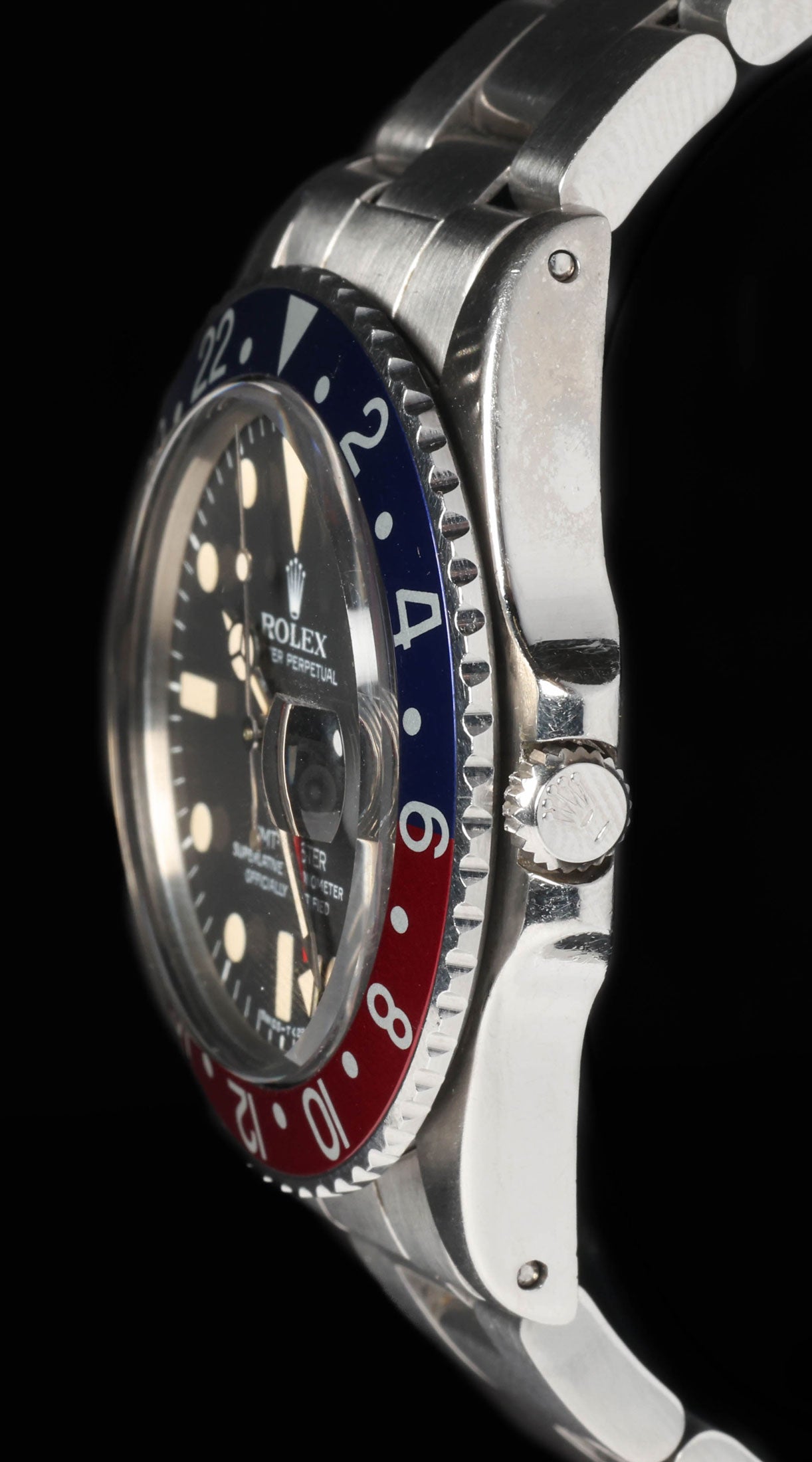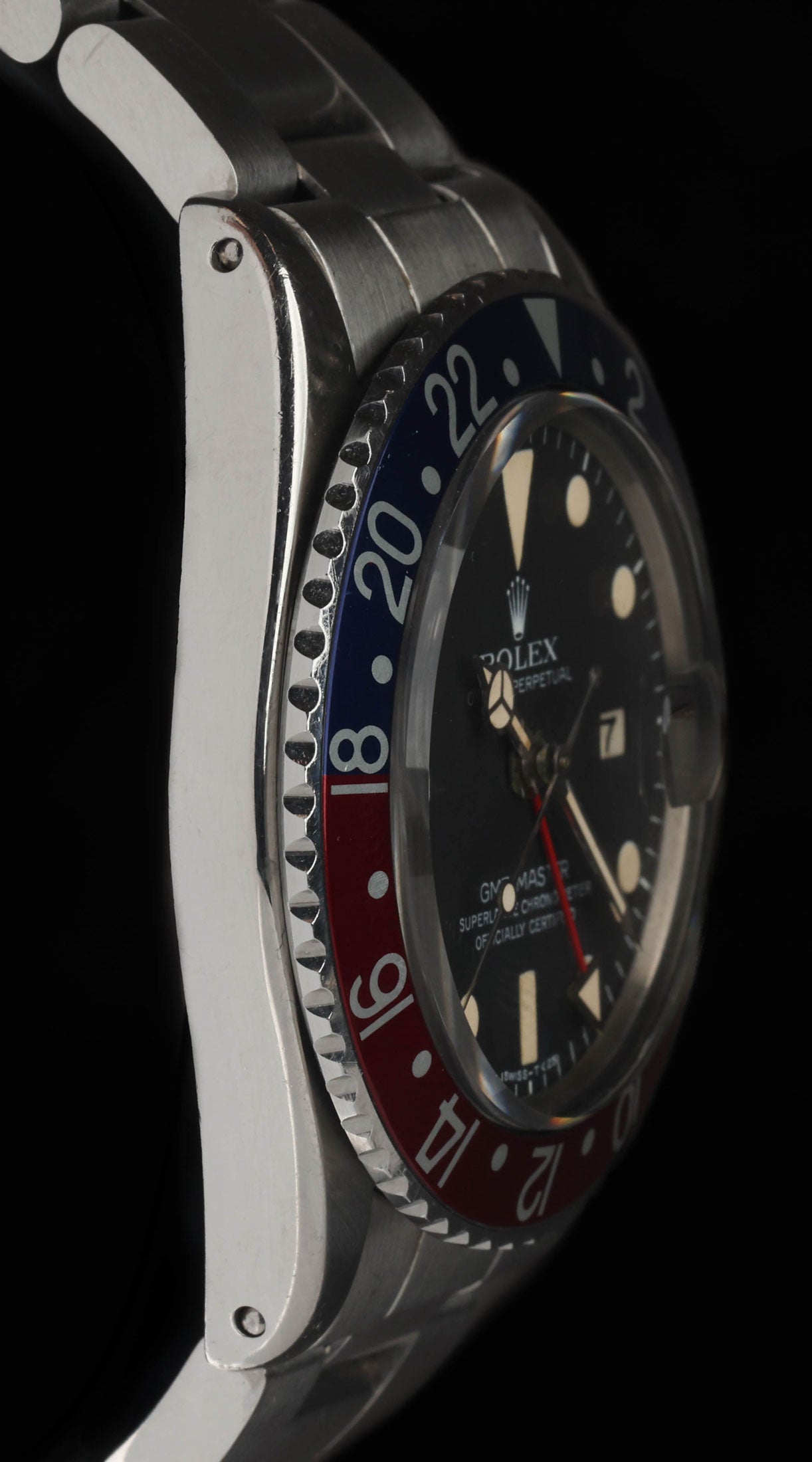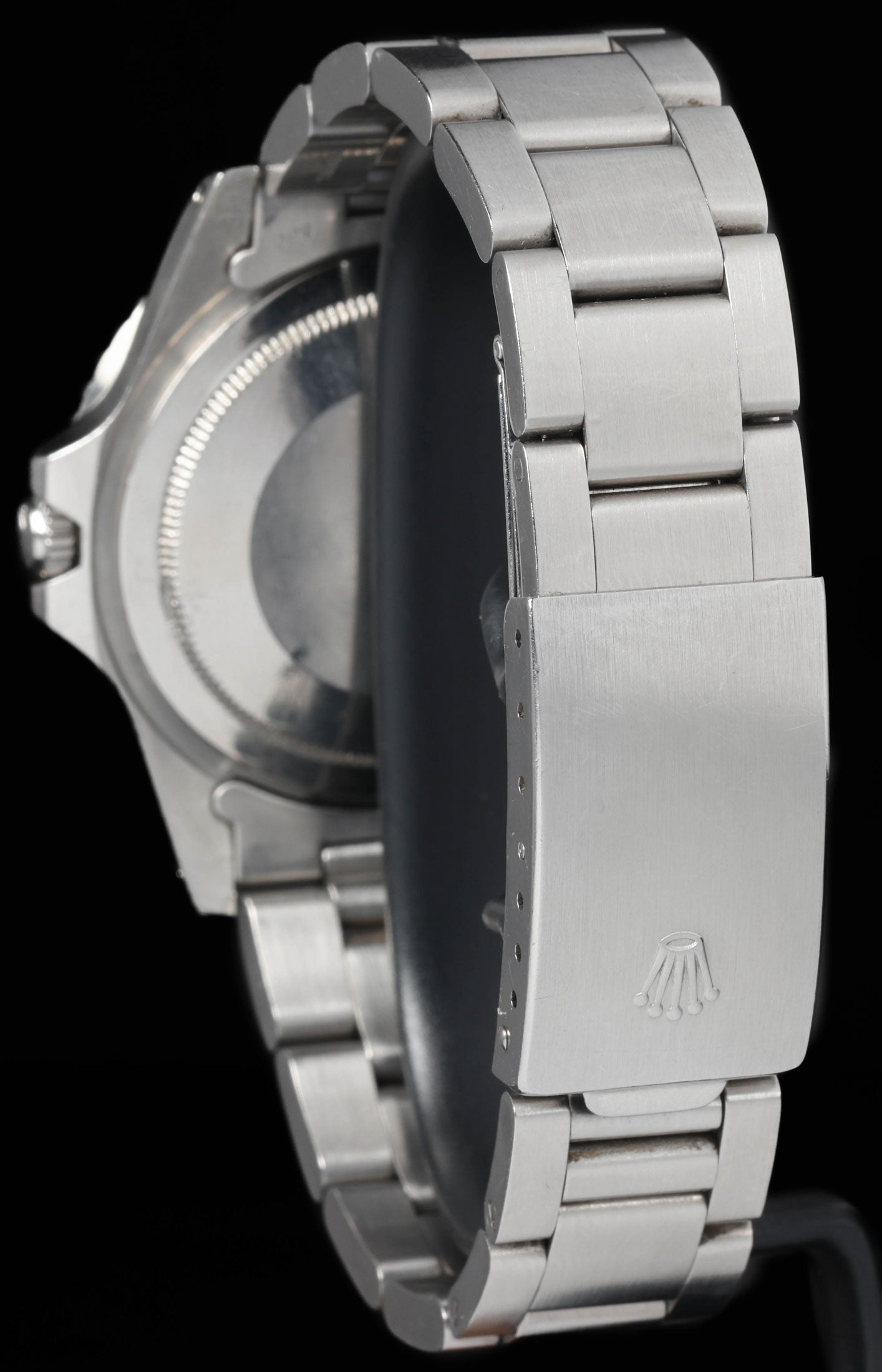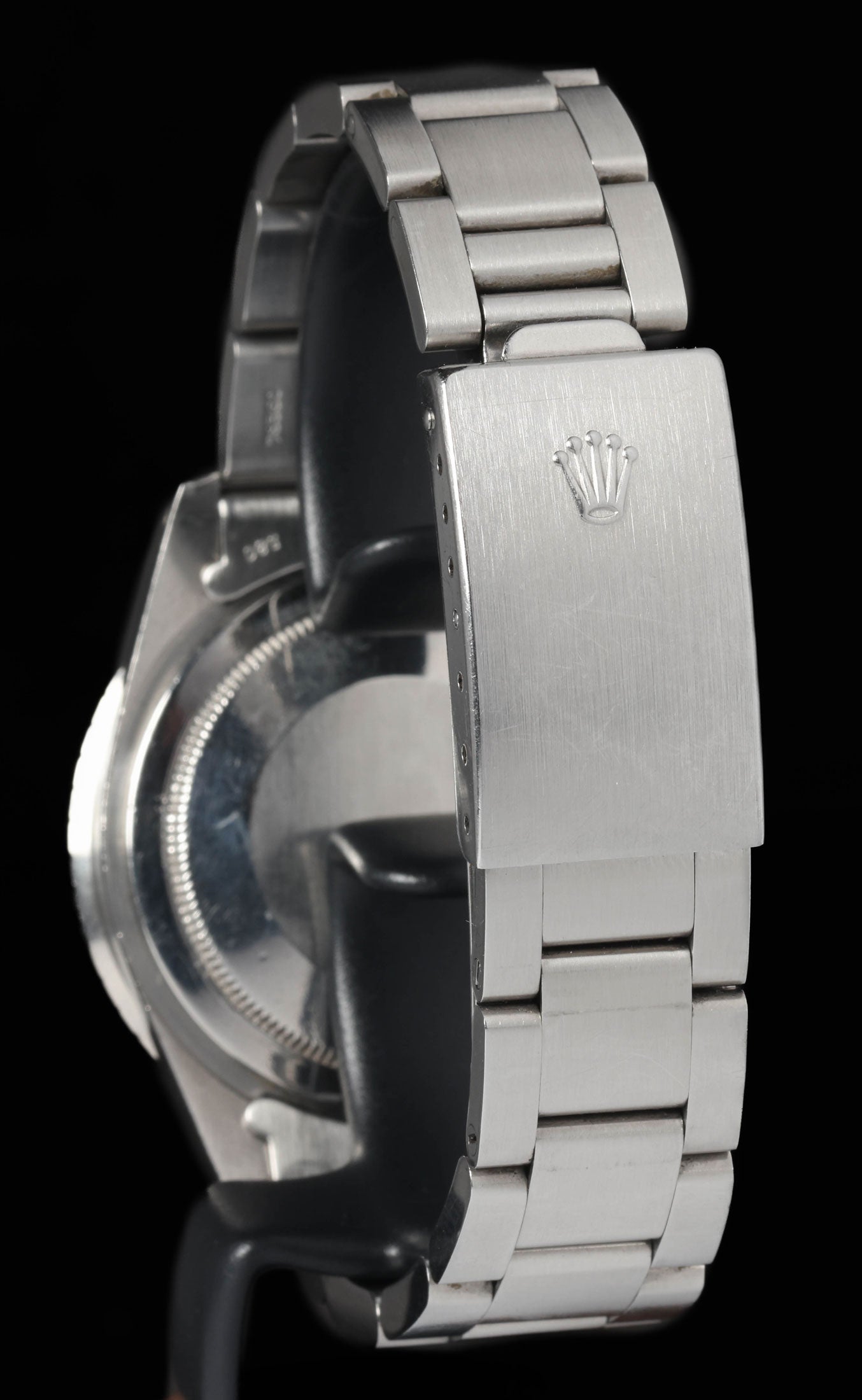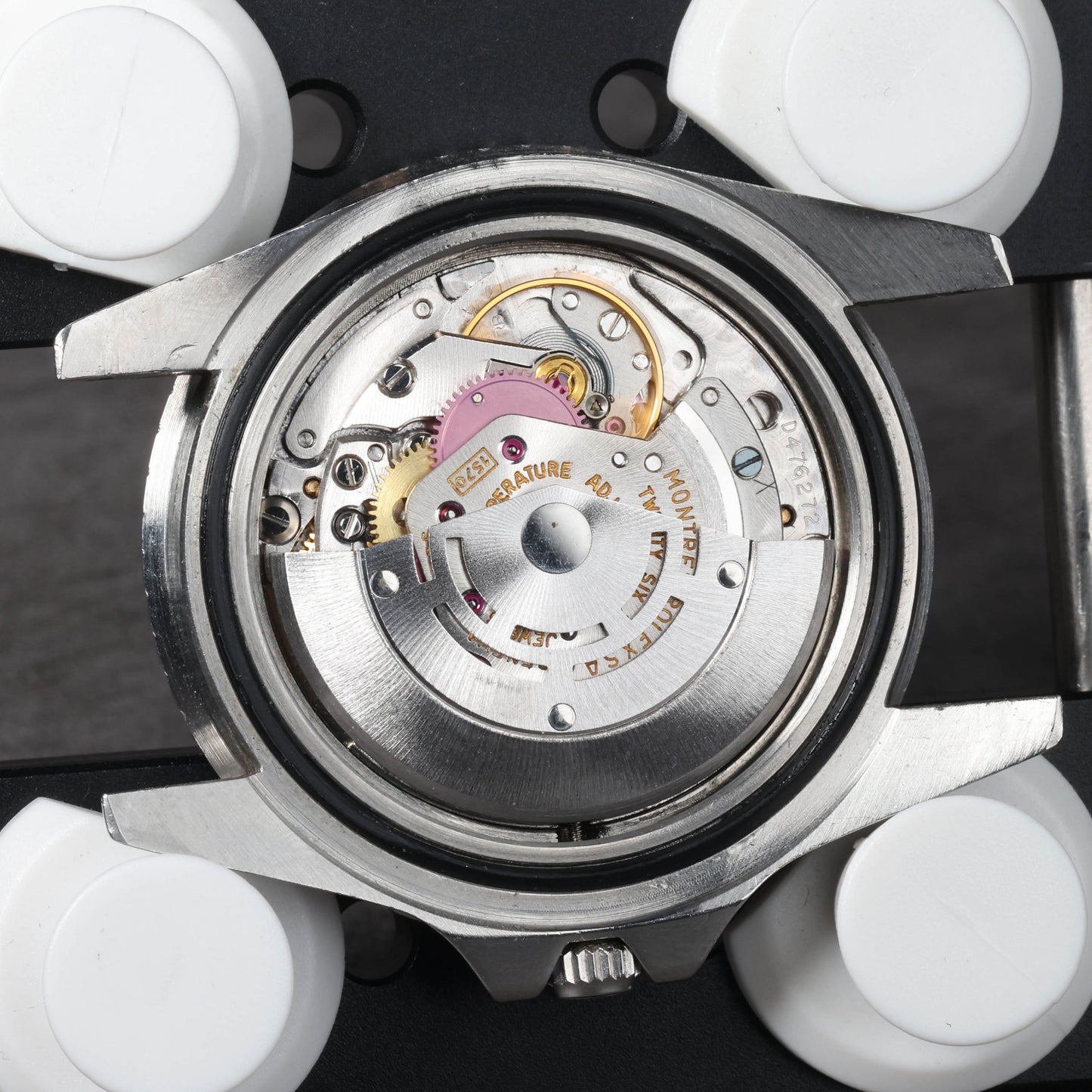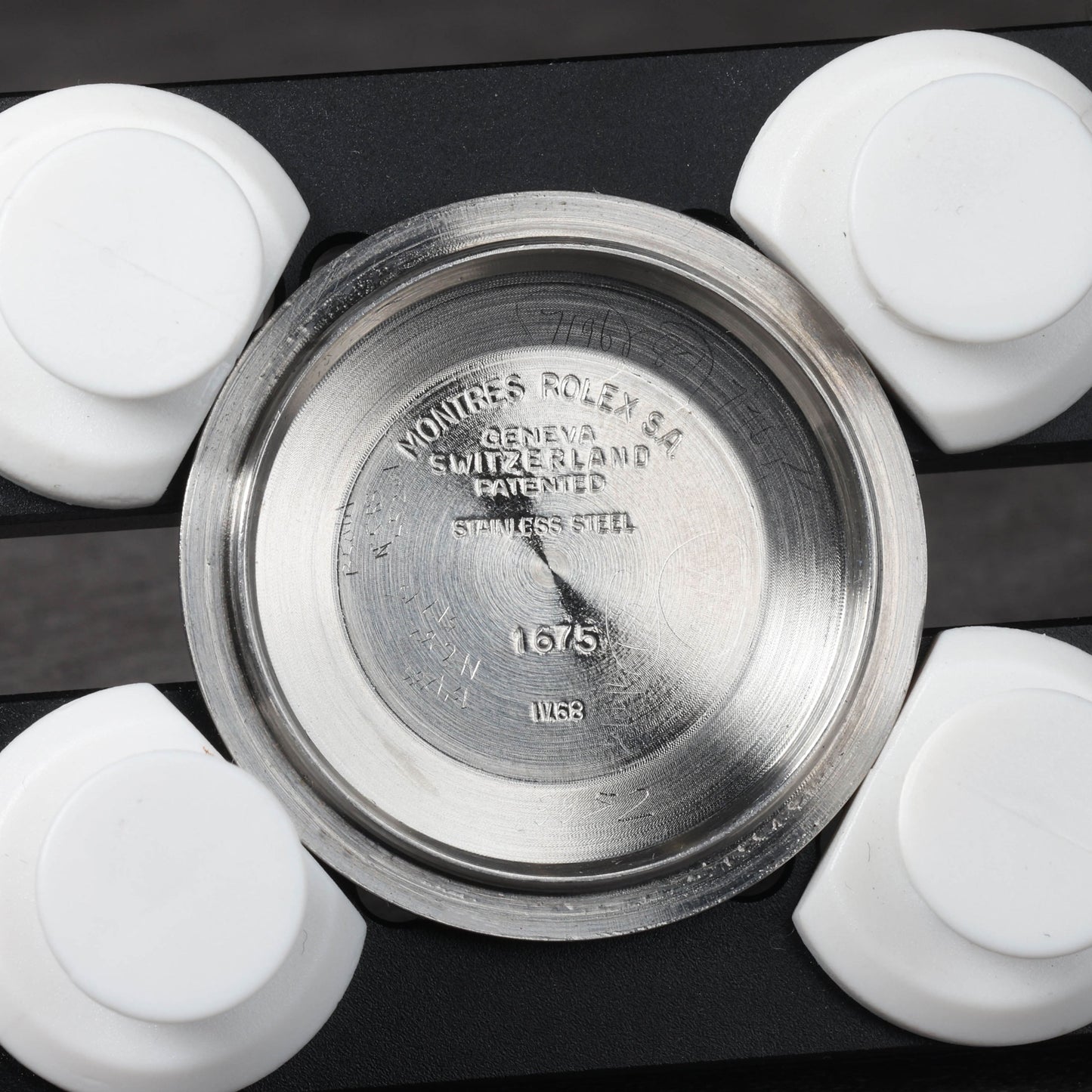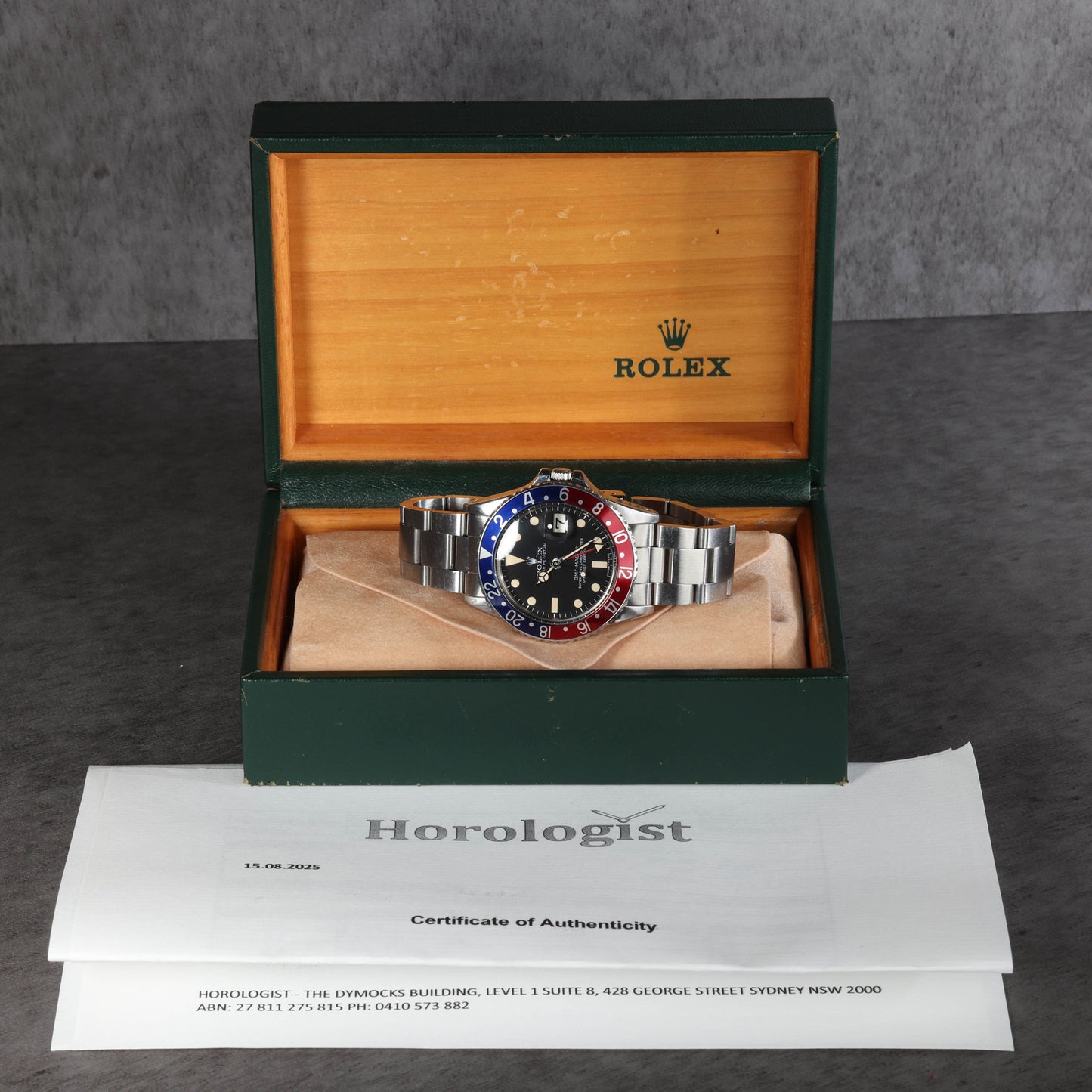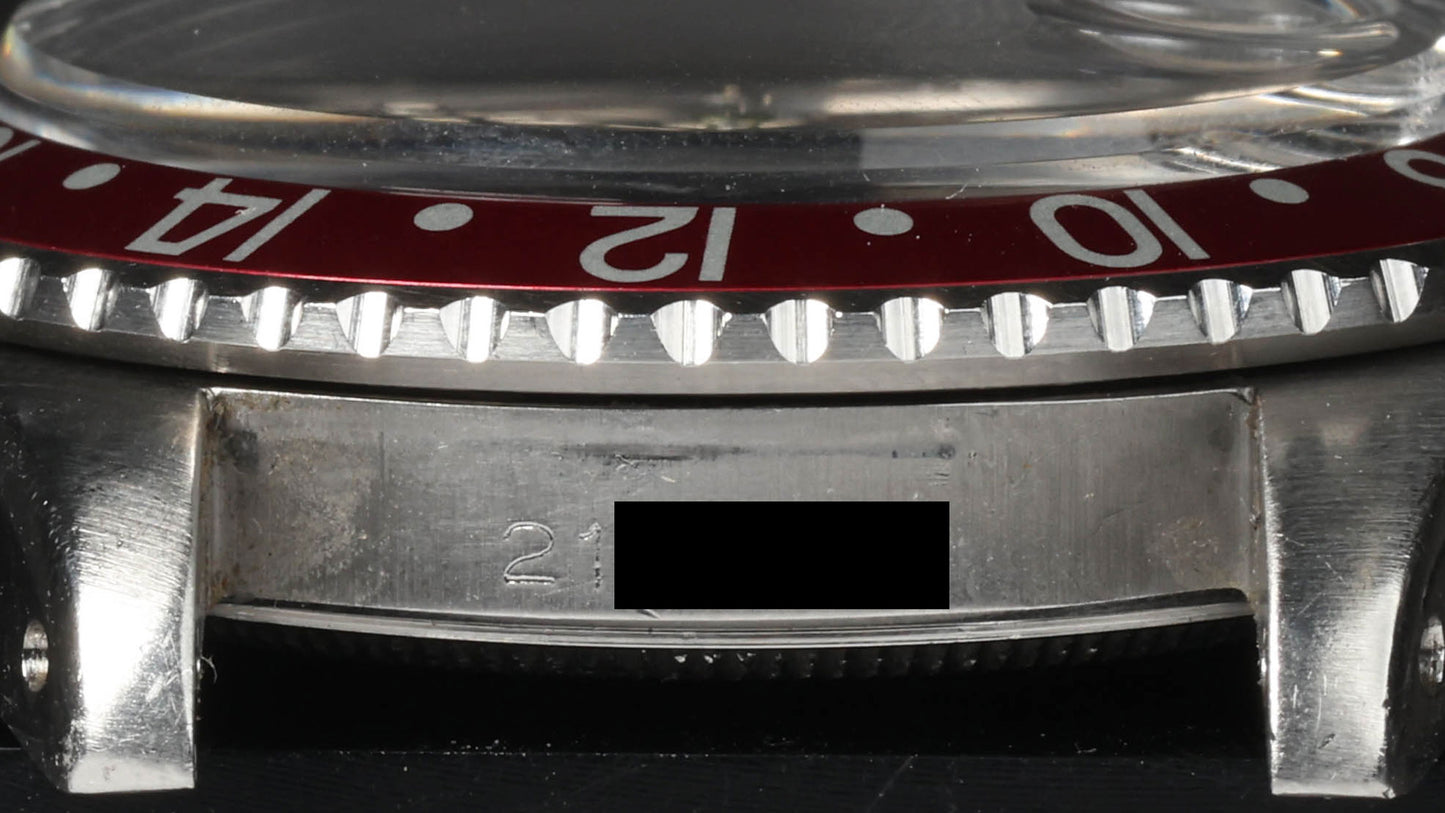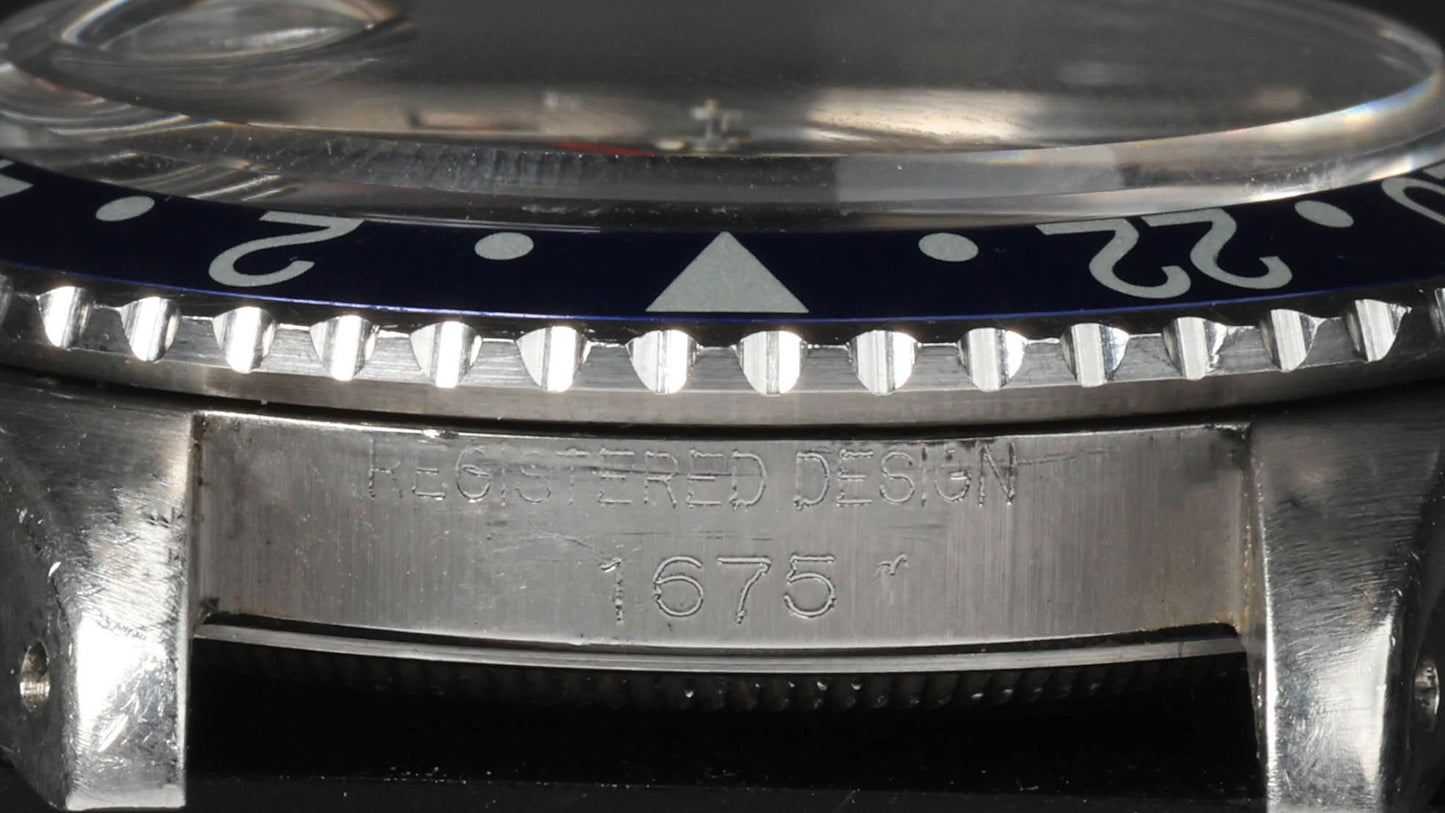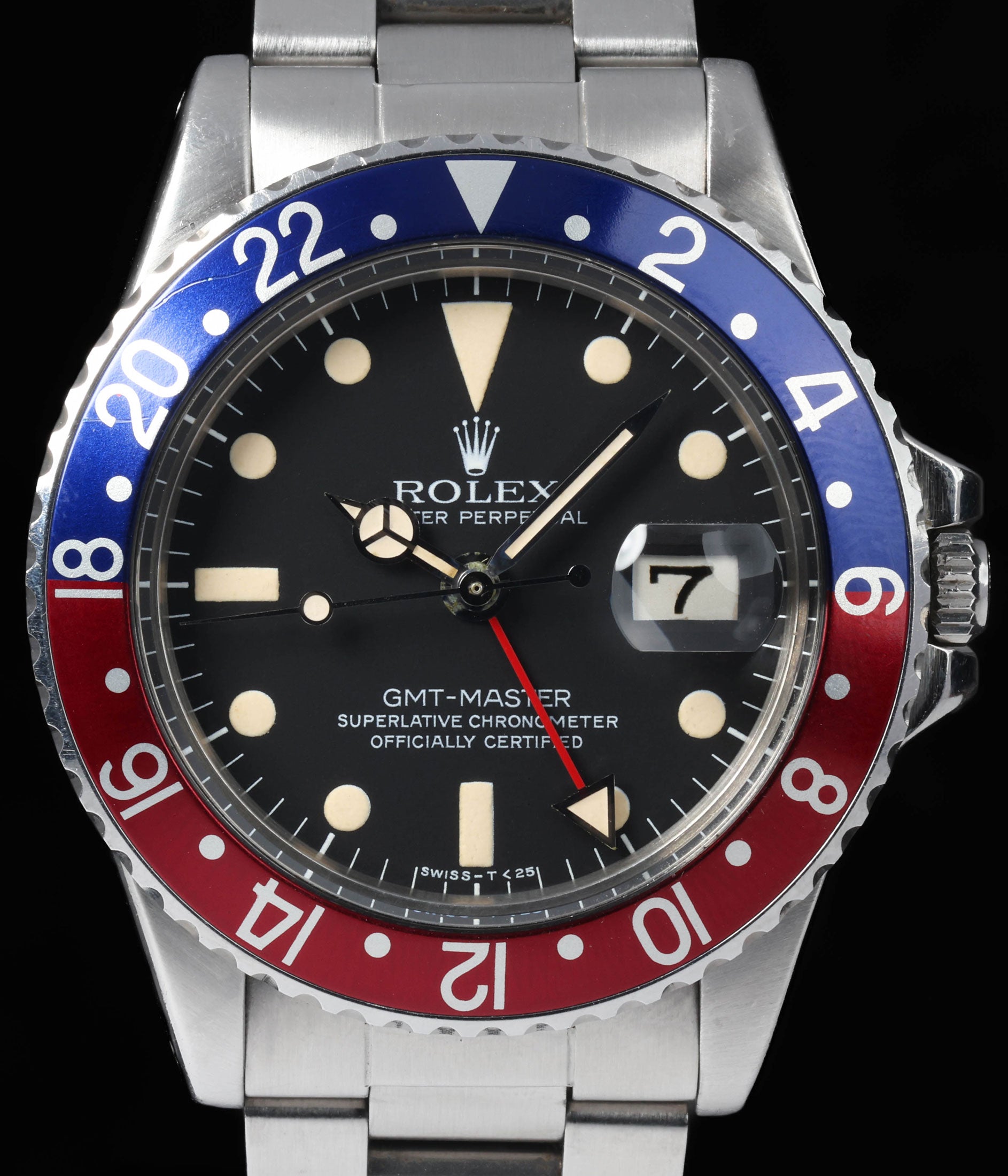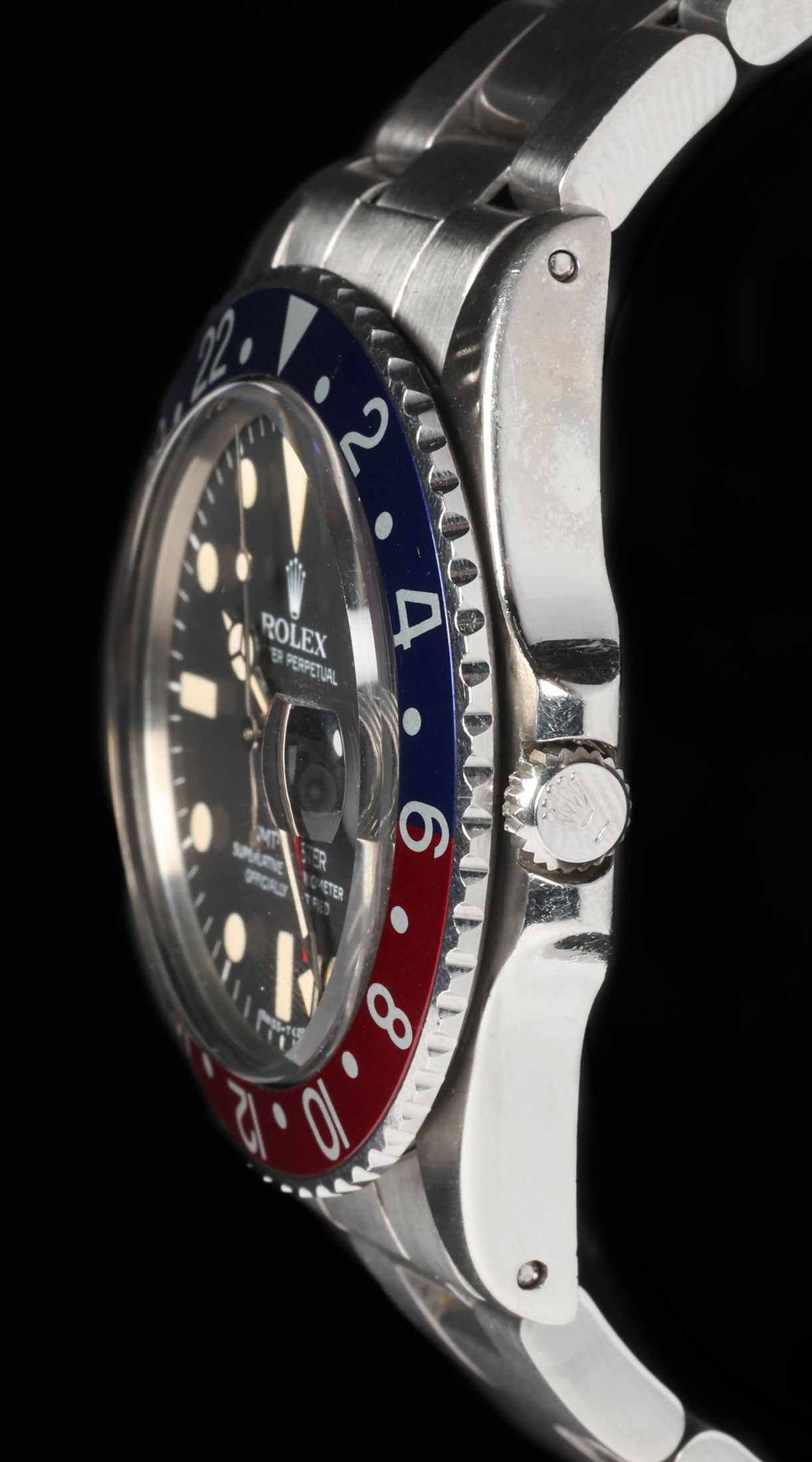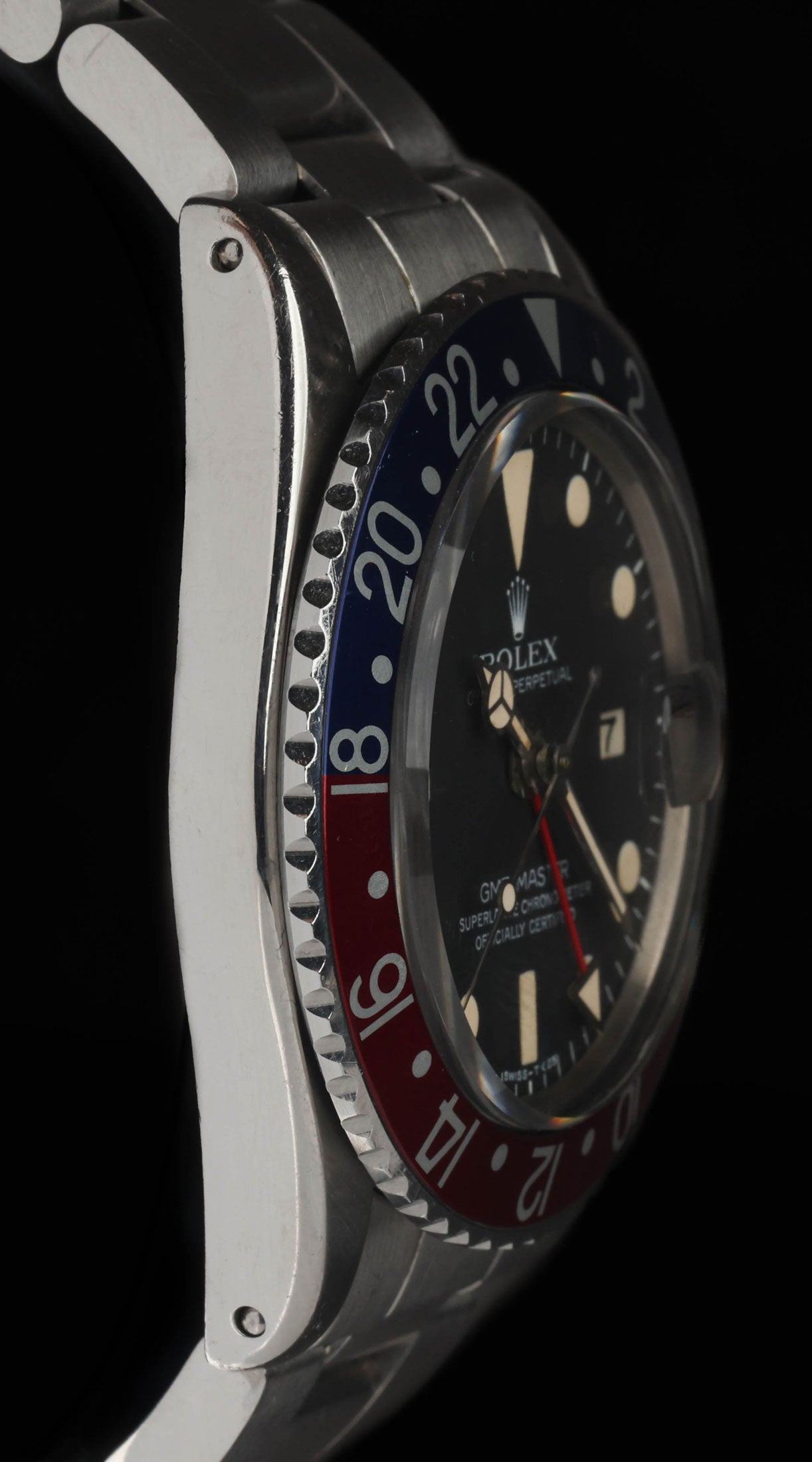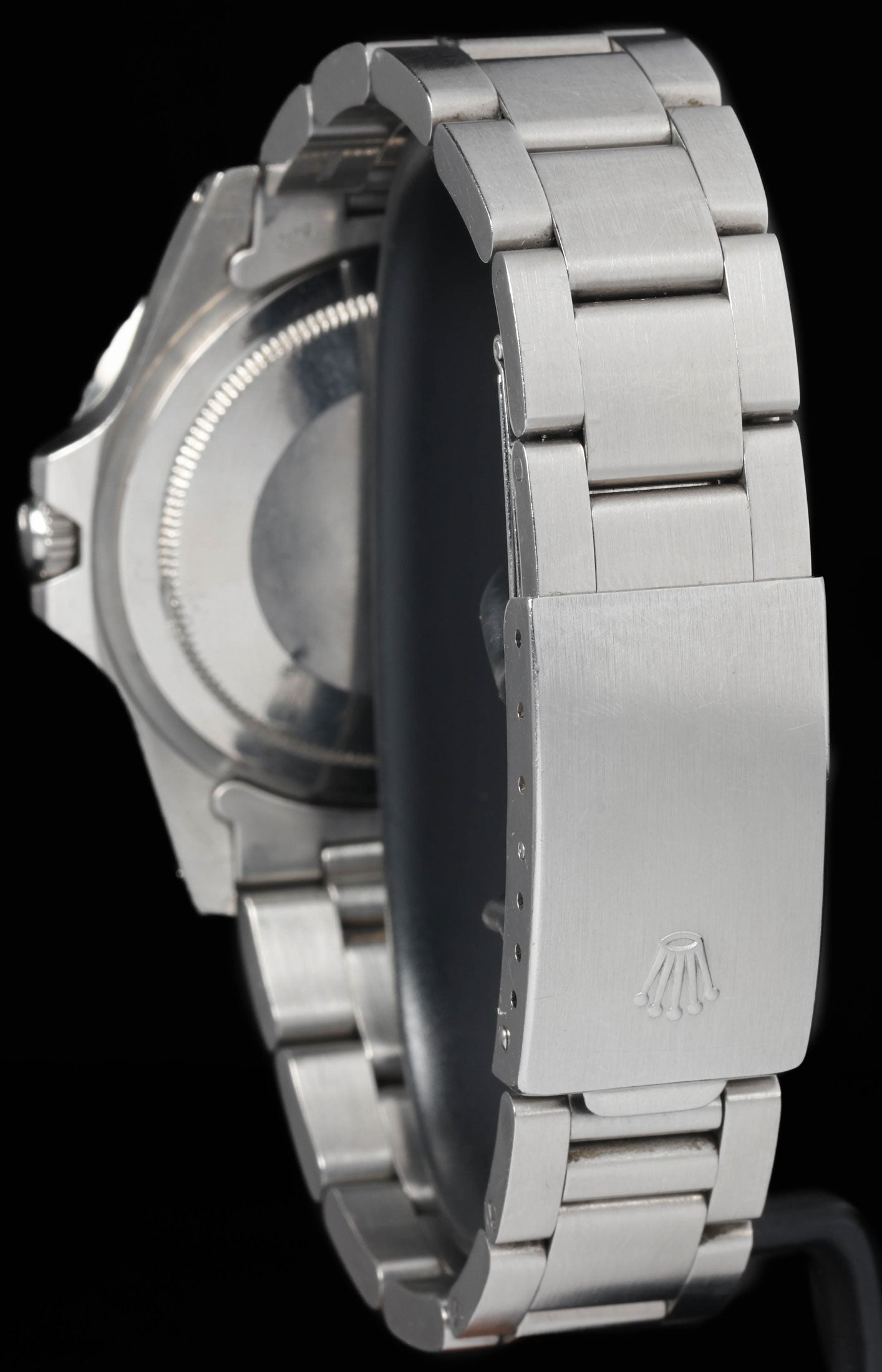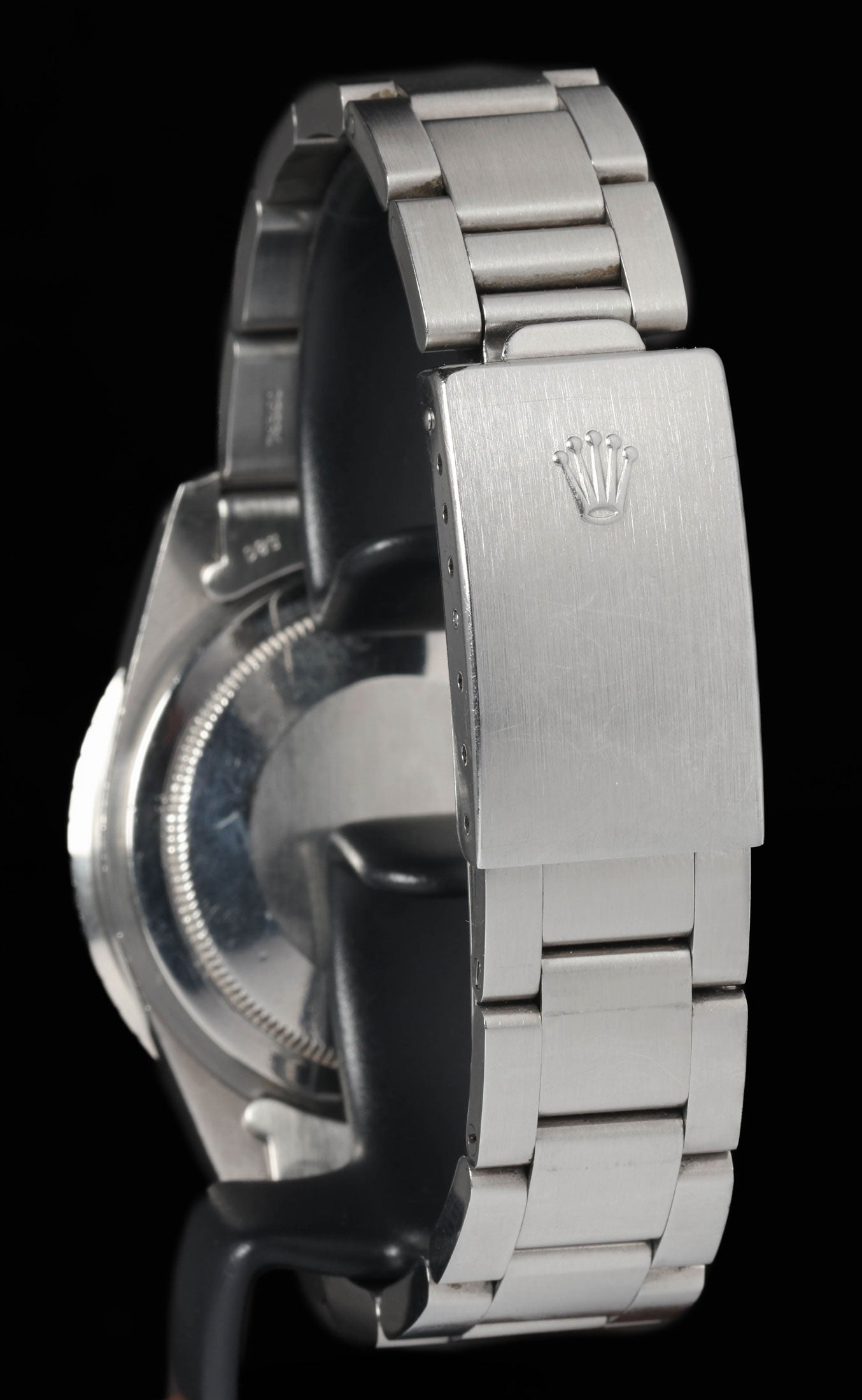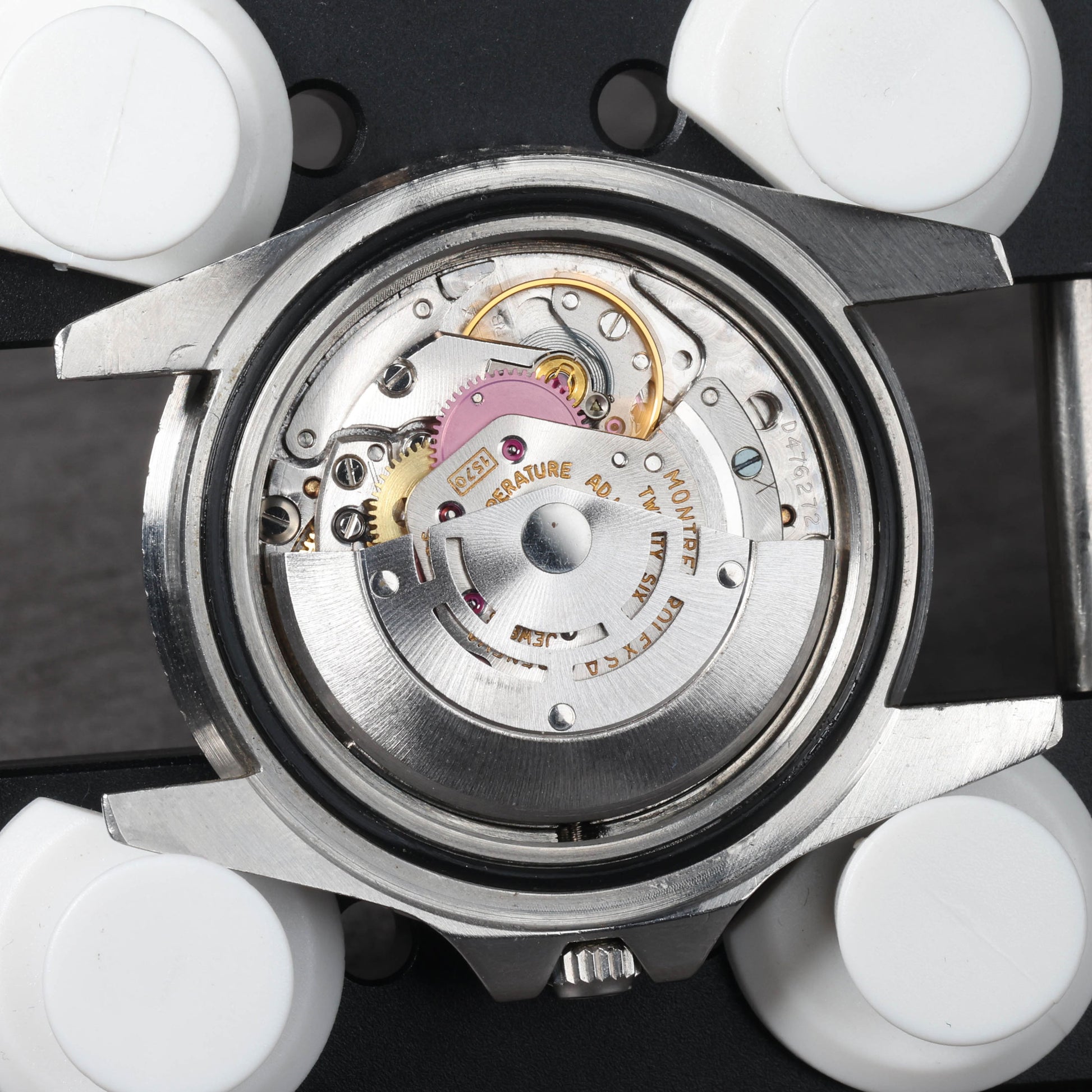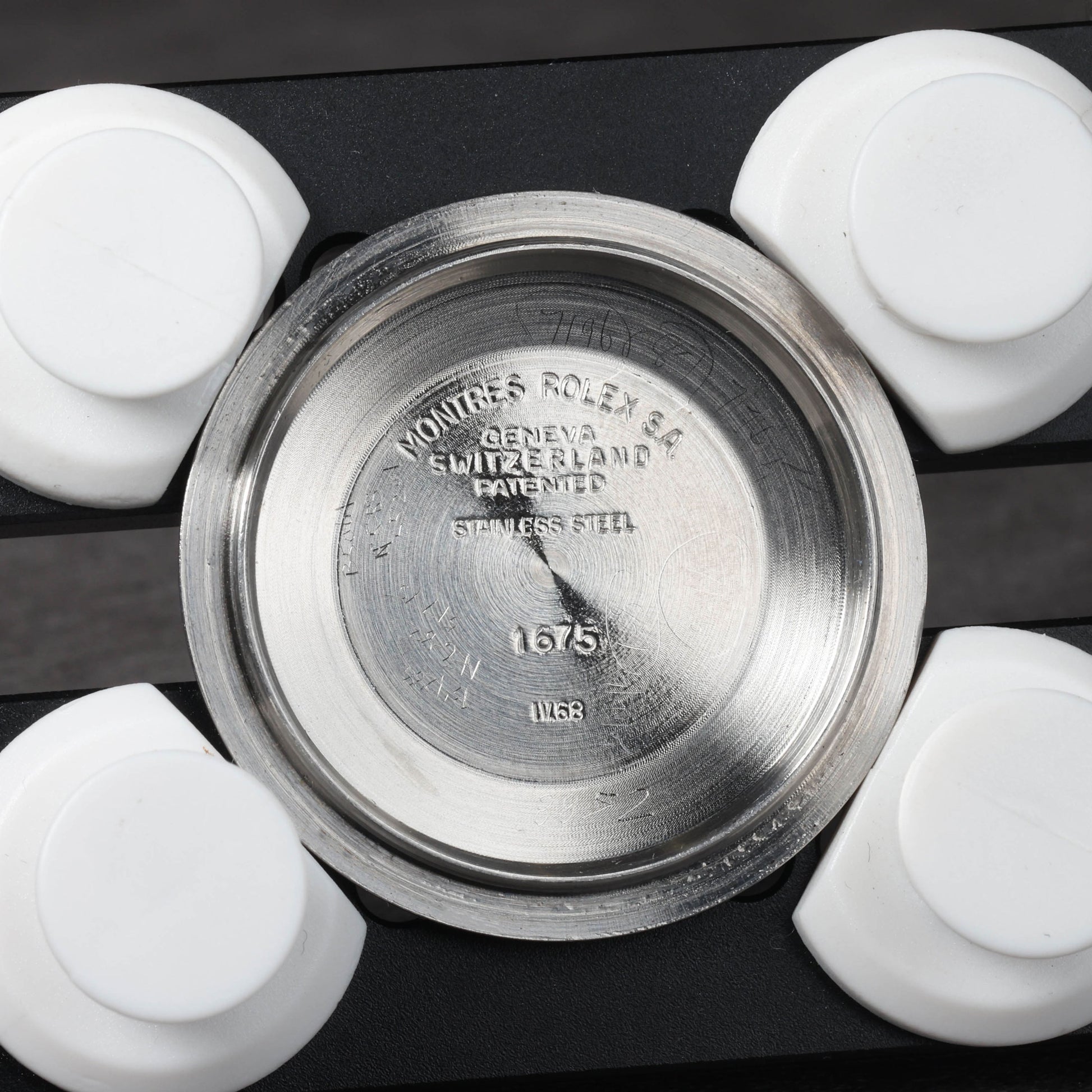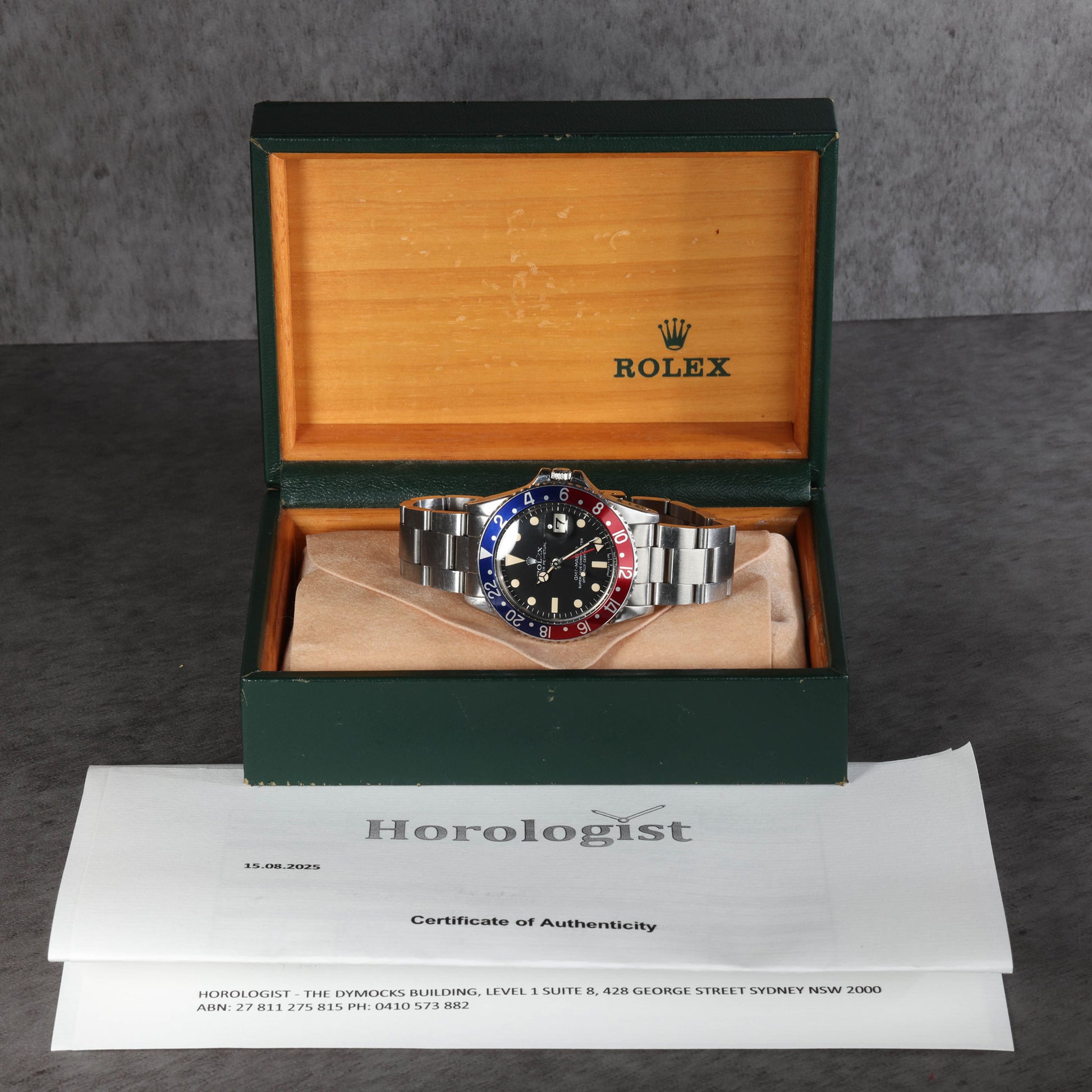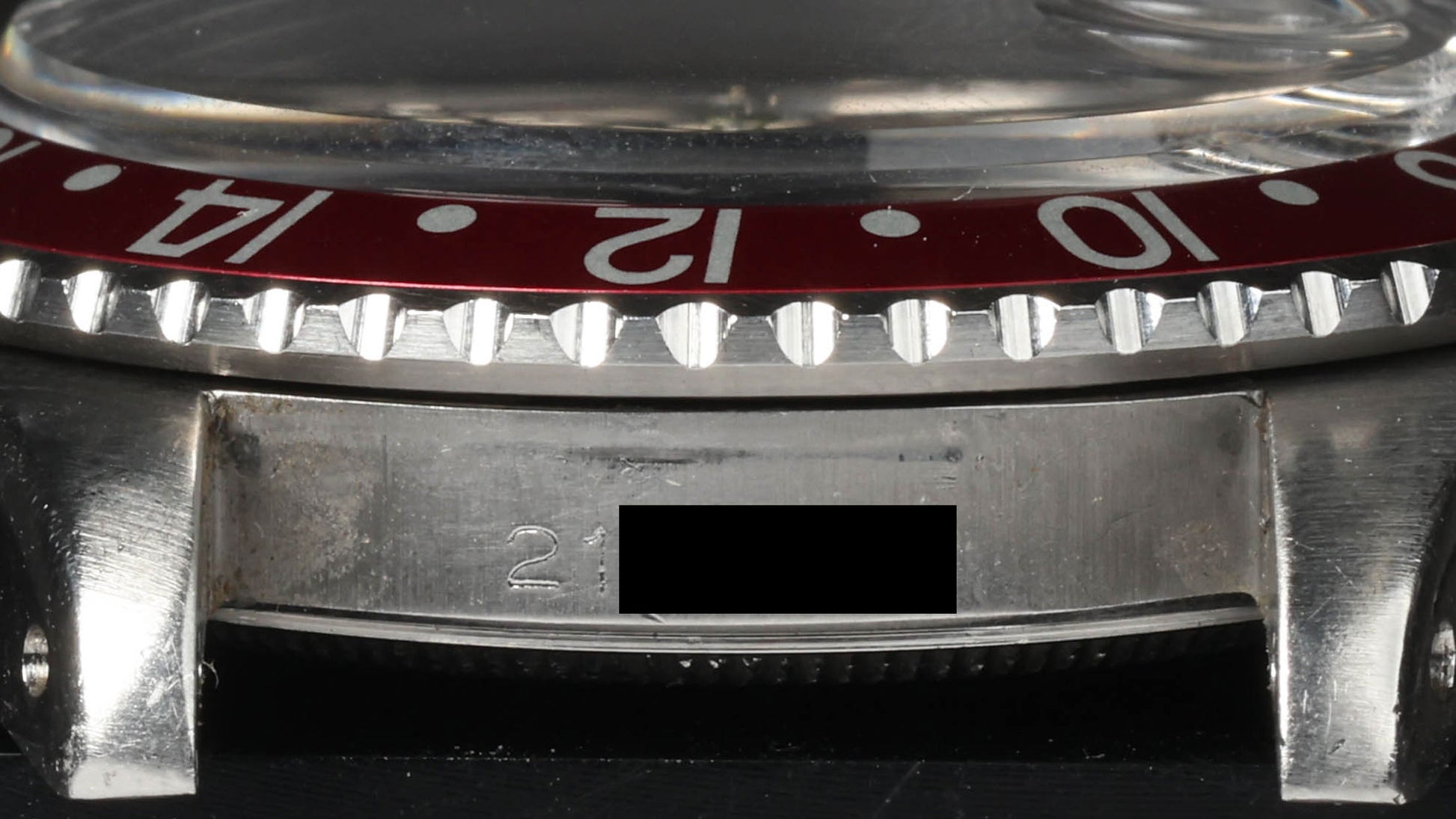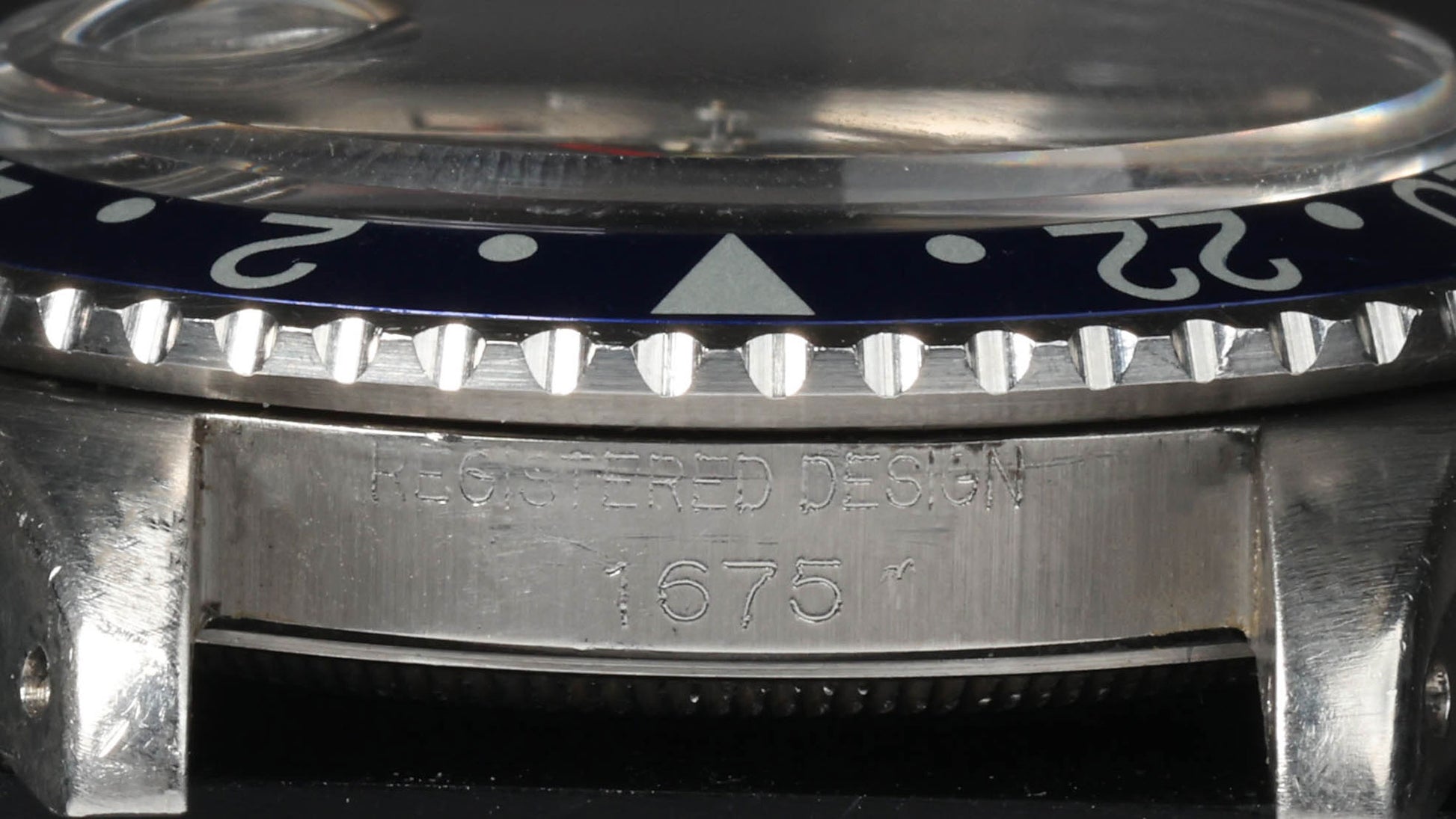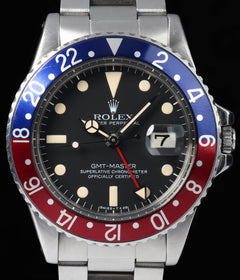Crown Vintage
Rolex GMT Master 1675 40mm 1969
Rolex GMT Master 1675 40mm 1969
Couldn't load pickup availability
Rolex GMT Master 1675
The case presents in good vintage condition with light hairlines visible across the flanks and lugs. Factory chamfers and longitudinal brushing remain evident, and the overall geometry appears crisp with no signs of heavy refinishing. The bracelet is a 78360 service Oyster showing minimal stretch and light wear; links articulate smoothly and the clasp closes securely. The dial and hands are in excellent condition with clean print and warm patina beginning to form on the luminous material. There is no oxidisation visible on the hands or dial.
Share
Why we love this watch
Why we love this watch
Rolex GMT-Master 1675 — The Classic Twin-Time Pilot’s Watch
Origins of the GMT-Master
Jet Age Problem-Solving
The GMT-Master was born as air travel went intercontinental. Long-haul pilots needed a clear way to track two time zones at once: home base and destination. The solution paired a conventional 12-hour handset for local time with a dedicated 24-hour hand for reference time. A rotating 24-hour bezel completed the system, allowing the wearer to reconcile time zones at a glance without mental arithmetic or fragile complications.
The Day–Night Bezel Concept
A two-colour bezel insert split into dark and light halves made the 24-hour scale immediately readable: darker tones for the night hours, lighter for day. This simple visual code, combined with bold numerals and a luminous triangle at “24,” turned the watch into an intuitive cockpit tool. The concept endured because it solved the travel-time problem with minimal parts and maximum clarity.
Evolution to Reference 1675
Case Guardians and Proportions
With the 1675, the model settled into the proportions many now consider the archetype: a 40 mm case, 20 mm lugs, and trim mid-case walls that keep the watch slim on the wrist. Crown guards—first introduced on the line shortly before—were refined to a squarer profile, shielding the screw-down crown while preserving a svelte silhouette. The result is a case that wears flatter than the dimensions suggest, with lugs that arc neatly and a coin-edge bezel that’s easy to grip.
Movement Progression: Cal. 1565 to 1575
Over its run, the 1675 moved from calibre 1565 to 1575, bringing a higher beat rate and incremental reliability improvements. In this tritium-dial period, the calibre typically does not hack, so the seconds hand continues to run during time-setting. The movement remains automatic and robust, with a straightforward gear train driving the 24-hour indication and a date mechanism advanced via the hands rather than a quick-set. That mechanical simplicity supports durability while keeping the interface intuitive.
The Tritium Era
Dial Markings and Lume Behaviour
Dials from this period are marked to denote tritium-based luminous paint. Originally chosen for dependable low-light legibility, tritium’s glow fades over decades, but it leaves a visual signature many appreciate: hour plots that shift from stark white toward cream, custard, or pumpkin. Hands from the same era often mellow in step. The result is a dial that reads calm and even, with depth created by colour rather than gloss.
Matte Dials and Legibility
Matte black dials are central to the personality of this era. Without reflective lacquer, the surface absorbs glare so the print can do the work: crisp minute hashes around the perimeter, strong depth-rating lines, and generously sized geometric markers. Under the slightly domed acrylic crystal, the combination produces legibility that holds up in bright sun, cabin light, or a dim terminal. The acrylic’s edge distortion adds a gentle vintage charm without obscuring essential information.
Design Language and Wear
On-Wrist Proportions
The 40 mm case sits low thanks to slim case walls and a modestly raised crystal. Tapering lugs, a narrow rehaut, and the disciplined overhang of the bezel create a clean frame for the dial. On a riveted or folded-link Oyster, the watch feels feather-light; on a Jubilee, it drapes with an articulate, almost liquid motion. Either way, the head and bracelet balance well, so the watch centres naturally on the wrist and disappears in day-to-day wear.
Acrylic Crystal and Bezel Interaction
The acrylic crystal rises just above the aluminium bezel insert, catching light softly and diffusing reflections across the dial. The bezel’s bidirectional click is positive without being stiff, letting you offset the 24-hour scale against the fixed GMT hand in seconds. That tactile, tool-like interface is part of the appeal: neither delicate nor crude, simply exact enough to trust without thinking.
Bezel Function and Colour
Day–Night at a Glance
Beyond aesthetics, the two-tone insert is a dead-simple interface for time-zone maths. Set the red 24-hour hand to your reference (often UTC or home), align the bezel so “24” sits at the triangle, and local time reads off the main hands. If you need a temporary third time, rotate the bezel so the correct offset matches the GMT hand. No menus, no modes—just a mechanical logic you can operate mid-conversation.
Aluminium Inserts and Ageing
Aluminium inserts from this era carry a distinct anodised sheen and characterful print. Exposure to sunlight and use can mellow the colours, sometimes creating subtle gradient shifts. The numerals remain legible, the triangle at “24” anchors orientation, and the fine knurling on the bezel’s edge offers sure grip without visual bulk.
Practical Timekeeping
Using the 24-Hour Hand Daily
In daily use, the 24-hour hand remains a practical ally. Leave it set to your baseline time—home, UTC, or an important partner city—and allow the main hour hand to represent wherever you are. Conference calls, flight schedules, and deadlines across regions become second nature. The design’s strength lies in that clarity: two systems, one dial, no friction.
Non-Hacking Setting Technique
On non-hacking movements, precise setting is still straightforward. Pull the crown to setting position, wind backward slightly until the seconds hand reverses against the train and stalls momentarily, align the minute hand to the track, then release. Pilots used similar techniques to synchronise. The minute track’s crisp printing helps you set to the exact hash without hunting.
Case Architecture and Finishing
Brushing, Chamfers, and Crown Guards
Finishing on period cases follows a disciplined pattern: longitudinal brushing along the lugs, softer sheen on the flanks, and a clean demarcation at the lug bevels. Crown guards flow from the case band, protective but not bulky, framing a screw-down crown that sits neatly between them. Inside, the solid caseback secures a well-protected movement, and the overall geometry—thin mid-case, true lug lines, and narrow bezel overhang—keeps the watch visually calm and ergonomically easy.
Bracelets and Wearing Experience
Oyster vs Jubilee
The period correct pairings define how the watch feels. The riveted Oyster brings airy lightness and a tool-ish stance; the later folded-link Oyster adds a touch more solidity while staying comfortable; the Jubilee delivers an elegant drape without making the watch dressy. All options taper for balance, feature simple, secure clasps, and hug the case with end-links that complement the 20 mm lugs. Strap changes can pivot the watch’s mood, but the bracelets remain the most authentic extension of the design language.
Aviation and Cultural Footprint
From Flight Deck to Departure Lounge
The GMT-Master’s rise tracked the democratisation of air travel. What began as a pilot’s instrument soon became a practical aid for anyone living across borders—diplomats, journalists, touring professionals, and frequent flyers. The twin-time layout made global coordination easier: keep your anchor time constant, adjust the rest with a bezel turn. The two-colour bezel became a familiar sight in boarding queues and conference rooms alike, a shorthand for mobility as much as for aviation.
Why This Tritium-Dial Period Matters
A Cohesive Visual Language
This period balances durability with texture. Matte dials reduce glare and keep the layout flat and functional. Painted hour plots introduce depth without relief. Luminous material that has gently mellowed provides tonal warmth that complements the crisp white print. Under acrylic, the package reads as one system rather than a set of parts.
Materials That Tell the Story
Aluminium bezel inserts age gracefully, sometimes softening the border between colours; bracelets wear-in, not out, gaining suppleness while maintaining strength; acrylic crystals can be refreshed easily while retaining their signature warmth. Together they create a watch that looks ready for travel even when it’s sitting on a desk, because its materials were chosen for use rather than display.
Details That Define the Period
Hands, Fonts, and Engravings
The red 24-hour hand of this era typically features a smaller triangular tip, sitting just inside the bezel numerals for precise reading. Dial fonts are balanced in weight, with even minute hashes around the perimeter and clean spacing in the lower text. Case engravings between the lugs tend to be neat and shallow, reflecting production norms of the time. None of these details is loud; collectively they lock the watch into its historical window and reinforce the sense of purpose the design projects.
Everyday Practicality
Clear in Any Light
Large geometric markers—triangle at 12, batons at the quarters, and circles elsewhere—make orientation instant. The minute hand’s length meets the track exactly, aiding precise setting, while the red GMT hand’s contrasting hue ensures it never disappears into the dial. Acrylic diffuses specular reflections that would otherwise wash out glossy surfaces, so head-on visibility remains strong even under harsh light.
Travel Without Fuss
Operationally, the watch is as simple as its premise. Set the 24-hour hand to an anchor time, rotate the bezel for offsets when needed, and let the main hands handle local. For quick checks—what time is it back home right now?—the answer is a single glance. That kind of low-friction utility is why the layout continues to make sense long after its aviation origins.
Historical Significance
From Tool to Timeless Template
The GMT-Master 1675 refined a design that bridged professional demands and daily life. It captured the essence of the Jet Age—global movement, coordination across continents, and the need for dependable, legible instruments—without sacrificing wearability. By standardising proportions, protecting the crown with unobtrusive guards, and pairing an automatic calibre with an elegant 24-hour interface, the reference set a template that later models would build upon rather than overhaul.
A Quietly Influential Design
Much of its influence lies in restraint. The bezel carries information without clutter; the dial presents bold shapes and clean print; the movement delivers function without fussy complication. It is the kind of design that scales across decades because it starts from human factors—how eyes track information, how hands operate controls, how wrists carry weight—rather than ornament. In that sense, the watch is as relevant at a desk and on a video call as it was in a cockpit.
Final Thoughts
The Rolex GMT-Master 1675 from the tritium-dial period distils twin-time watchmaking to its essentials: a crisp matte dial, a red 24-hour hand, and a day–night bezel that turns quickly and reads instantly. Balanced 40 mm proportions, disciplined case finishing, and a robust automatic calibre make it effortlessly wearable, while the materials—acrylic, aluminium, steel—lend warmth and practicality. More than a product of aviation, it is a clear, durable tool for living across time zones, a design whose calm logic still fits the way people travel and work today.
Case & Bracelet
Case & Bracelet
- Case in good vintage condition, light hairlines visible.
- Factory chamfers & brushing still visible.
- Bracelet is 78360 service bracelet with minimal stretch & wear.
Dial & Hands
Dial & Hands
- Dial & hands excellent condition with warm patina forming.
- No oxidisation.
Warranty & Condition
Warranty & Condition
Crown Vintage Watches provides a minimum 3-month mechanical warranty on pre-owned watches, from the date of purchase.
The warranty covers mechanical defects only.
The warranty does not cover damages such as scratches, finish, crystals, glass, straps (leather, fabric or rubber damage due to wear and tear), damage resulting from wear under conditions exceeding the watch manufacturer’s water resistance limitations, and damage due to physical and or accidental abuse.
Please note, water resistance is neither tested nor guaranteed.
Shipping and insurance costs for warranty returns to us must be covered by the customer. Returns must be shipped via traceable courier. Return shipment must be pre-paid and fully insured. Collect shipping will be refused. In case of loss or damages, the customer is liable.
Our Pledge
At Crown Vintage Watches, we stand by the authenticity of every product we sell. For added peace of mind, customers are welcome to have items independently authenticated at their own expense.
Condition
Due to the nature of vintage timepieces, all watches are sold as is. We will accurately describe the current condition and working order of all watches we sell to the best of our ability.
Shipping & Refund
Shipping & Refund
